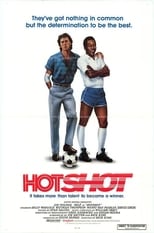To describe Bill King’s Hotshot in the vernacular of the 1980s, most of the time, this is a hokey soccer movie. But Hotshot is still worth watching, if only for the 20 minutes that Pelé is on-screen.
Pelé was a very fit 47 year old at the time, and those 20 minutes capture his movements in a way that help convey why he was a phenomenon. As Shep Messing wrote in 1977, “He carries himself with a grace, humility and dignity that is unparalleled.” Even the way Pelé falls in beach sand is graceful, with total body control.
The story
Jimmy Kristidis (Jim Youngs) is the spoiled son of a Greek shipping tycoon. He skips college to become a pro soccer player, outraging his parents. He makes the local team, the New York Rockers, but can’t get any playing time. He decides that he can get better faster if he is mentored by Pelé, so he sells Dad’s $30,000 Jaguar and heads to Brazil.
As Pelé tutors Jimmy one-on-one in the art of futebol and the beautiful game, my thoughts bounce back and forth like the ball: normal athlete, phenomenon, normal, phenom… Pelé is a wonder to watch.
How the movie got made
According to @Hidden_Films, Writer-Director Bill King, of Point Break fame, was brought in to fix a script for Greek New York real estate tycoon Steve Pappas. King pickpocketed a few ideas from the 1984 Karate Kid. Jimmy’s character became an over-confident asshole, and Pele ended up playing himself as if he were Mr Miyagi. Pele hides from the world in a small house in the jungle/countryside, where he hacks down brush to grow his garden. He refuses to play soccer, until gradually Jimmy gets him to embrace the game again.
Was Pelé really a recluse in the 1980s?
It intrigued me if Pelé had really become a recluse and wished to return to his real self of Edson Arantes do Nascimento. Shep Messing—who has also been a business partner—wrote that:
… [Pelé] simply shuts his eyes to close off the rest of the world that wants to touch him, talk to him or get an autograph on an airline napkin. “It is sometimes the only way to be alone,” he told me. “Very simple to close the eyes.”
– Shep Messing
Numerous fact lists about Pele hold few entries for the 15 or so years after his 1977 retirement from playing. He made a few movies and had plenty of girlfriends, and I assume he had an active social life despite not being in the limelight. (*see update below) He has fathered 7 children from 4 women. So the idea of his becoming a reclusive Edson must be pure fiction.
In 2011 he consolidated his brand under Legends 10 and began to make a steady income via globe-trotting appearances and pitches on behalf of many sponsors. Read S.L. Price’s 2014 Sports Illustrated article on Pele’s many financial issues and how everyone wants a piece of the guy.
Extra treats in the film:
- Billy Warlock of Baywatch is an Italian atomic ant whose unfortunate injury helps Jimmy find his humanity and his leadership qualities
- Mario Van Peebles literally dances on the field–and does little else–as a rastafarian Jamaican player
- Shep Messing and Jimmy Smits are listed as soccer players in the cast, but I didn’t quite catch them
Except for Pelé’s touches, the soccer in the film is pretty contrived, and there are mixed metaphors with the pointy ball game. For a complete synopsis of this football film with photos, see Adam Hurrey’s writeup.
Other football films on this site about Pelé include Pele O’Rey, Pele: Birth of a Legend, Once in a Lifetime – The Story of the New York Cosmos, and Pelé.
7 Soccer Movie Mom Rating = 7
Resources:
- Released: 1987-01-23 (USA)
- In English
- The film was known as Football Kid and is also frequently spelled as Hot Shot.
- IMDB
- Director: Rick King
- Stars: Jim Youngs , Pelé , Billy Warlock
- Watch the Trailer
* Update Aug-6-2017:
Hotshot spurred my interest into what Pelé had done during the 1980s, as a Google search turned up very little about him. Had he really been a bit of a hermit, as this movie portrayed?
To find out, I read the 2000 book “Pelé : His Life and Times” by Harry Harris. In the 1980s, Pelé served as a Goodwill ambassador for Pepsi and UNICEF, touring the world and conducting soccer clinics. He also signed with Warner Brothers to do 4 films. His return to the global stage started with the 1990 formation of Pelé Sports and Marketing, which sealed sponsorship deals with Mastercard and Umbro.
That answered my 1980s question, but I was surprised to learn in this book that around 1999-2000, the Daily Mail reported that Pelé had had a homosexual experience in his youth. People believed the gay rumor originated from Diego Maradona. I don’t care if any part of the story is true or not. I just found it interesting because it helped explain the enmity between Pelé (a man with few enemies) and Maradona (a man we all love to pile on if we are not Argentine). The enmity was not just about competitiveness and being the World’s Best.

